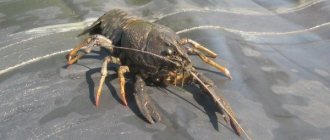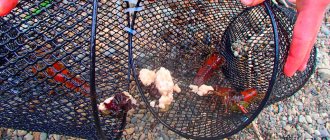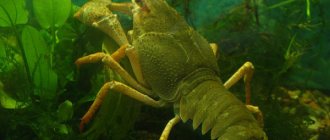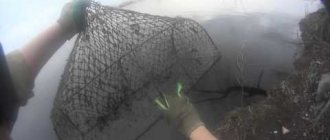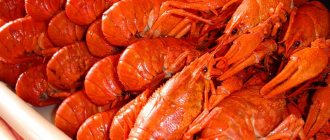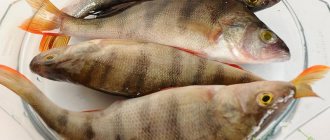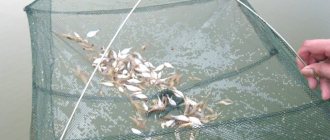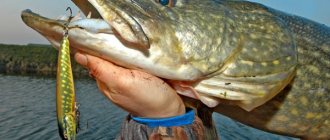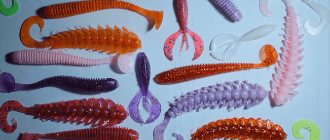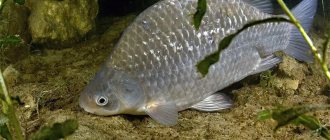Crayfish are higher crustaceans. The body is divided into two parts: a flat arthropod abdomen and a cephalothorax, which are covered with an exoskeleton of hard chitin. Often you come across green and gray crayfish. Sometimes blue, and even less often red. It all depends on the environment the cancer lives in. The less noticeable the color of the cancer, the more likely it is to hide in the environment and survive.
Crayfish are most vulnerable immediately after molting. At such moments, even a frog can tear them apart. Other crayfish also don’t mind eating a freshly molted relative.
The cephalothorax is the fused anterior and thoracic parts. On the front part there is a sharp spike, near which there are eyes on movable stalks. Cancer breathes through gills. Crayfish jaws are modified limbs that are located on the sides of the mouth.
To move along the bottom, the crayfish has 4 pairs of single-branched thoracic limbs. The fifth pair are claws, which are intended for defense and attack.
To swim, the crayfish uses 5 pairs of two-branched limbs located on the abdomen. The caudal fin of the crayfish is formed by the seventh abdominal segment and the sixth pair of abdominal legs.
Males are larger than females and have massive claws. If a limb is lost, the cancer grows a new one gradually with each subsequent molt. The frequency of shedding depends on the oxygen content and lime dissolved in the water. The main criterion is that the water is not too acidic.
The female carries the eggs on two-branched limbs under the tail. The emerging crustaceans are already able to feed on their own and hide from their older relatives.
Habitats of arthropods
Crayfish live at a depth of 0.5-3 m. They choose places without silt, where the soil is solid. This is due to the fact that on a muddy, sandy bottom, as well as in flat and clean shallow water, crayfish will not dig a shelter for themselves.
Crayfish also settle on rocky bases, where there are many shelters, or on the bottom, which is suitable for digging holes. Crayfish burrows can be seen in coastal holes or under steep banks.
In the best places, large males make burrows
Often they are on the verge of crossing the hard and soft bottom. Crayfish dig holes up to one meter deep. The entrance is often hidden under a sunken tree trunk, the roots of willows growing above the shore, or stones.
The habitability of the hole is indicated by the presence of freshly dug soil near the hole. Also, the owner can be driven out of the hole by the strongest enemy. That is why the holes themselves are narrow, so that the crayfish can close its claws in it from the enemy.
The young settle in shallow water near the coastal line, under branches, stones and leaves. Females and weak males stay a little further from the burrows of large males and in less favorable areas. Such as, for example, under the roots of reed thickets.
Crayfish bait
Below are the most commonly used baits for crayfish fishing. They can be combined. A good result is achieved by alternating fishermen at the fishing spot with various baits. For example, in one farm there will be fresh meat, and in another there will be rye bread.
Fresh fish or meat
The best option for catching crayfish is fresh meat or fish cut lengthwise and turned inside out. You can also cut it into small pieces and wrap it in cheesecloth.
It has been noted that crayfish prefers bream and roach. But it is not recommended to take pike and perch as bait.
You can add fresh dill leaves to the bait. He does not disdain frog meat or grasshoppers.
Such baits are used from spring to early autumn.
Moldy stuff
Although it is believed that crayfish eat rotten meat, they still prefer fresh meat. Most likely, this stereotype comes from the fact that crayfish concentrate in large numbers while feeding under the corpse of an animal.
When using rotten fish or meat, cut the bait along the back down to the vertebrae. This is done in order to turn the meat inside out.
An alternative to such bait would be fresh bird entrails, which are lightly fried in unrefined sunflower oil. This bait can be used until it is completely rotten.
Rye bread with garlic
Take fresh rye bread. The crust is rubbed with garlic, a hole is made in the crumb, which is then filled with crushed garlic.
When using such bait for a long period, it is prevented from swelling. To do this, the bread is placed in a bag made of nylon fabric or gauze.
You can also make a uniform mass of such bait. To do this, pass all the ingredients through a meat grinder. This bait is used in the warm season. You can use a few mint leaves to complement the garlic.
Peas
In winter , crayfish prefer plant baits.
The most justified and catchy bait is canned peas. The peas are poured into a gauze bag. After which the bag is attached to the clamshell. To enhance the aroma of peas, it is recommended to add ground dry dill or its seeds, passed through a coffee grinder.
An alternative to canned peas is boiled pea porridge, which is moistened with any vegetable flavoring. For example, flax oil.
Cake
Sunflower cake is a universal bait for any time of year. It is better to buy cake made from roasted sunflower oil. In other words, this oil is called unrefined.
If you have a choice in purchasing cake, it is better to buy pressed pancakes. They take longer to liquefy in water and can be used several times in a mesh bag.
What to use to catch crayfish?
Crayfish is found only in fairly clean water bodies and it will be impossible to catch it in muddy and dirty water. The main habitats are lakes and rivers without strong currents. Prefers reservoirs with a rocky bottom, as it will be easy for him to hide.
Cancer is a carnivorous animal, which is why meat is used as bait when catching it. He is also a scavenger, which means that he himself does not like to hunt, but prefers the bodies of dead inhabitants of bodies of water. But using rotten meat as bait will not lead to a good catch. To lure him into a trap, it will be enough for him to smell the strong smell of food. To spread the smell, you can cut the bait.
Choosing a shell
Rakolovka is also called recheshna or early. It is made from a mesh of wire or wood. The simplest design is the following: a mesh is stretched over a circle with a diameter of 0.5-0.7 m so that it sags in the middle. This crayfish-grip (crawfish-plate) performs well in slow currents and depths of up to 1.6 m.
Other designs are more complex; several rings or other geometric shapes made of wire of different sizes are used as the basis of the frame. To connect them together, a fine mesh is used.
Rakolovki are divided into two main types. These are open and closed. Let's look at them in detail.
Open
The already mentioned above-mentioned clamshell-plate belongs to this type. The main difference between open crayfish traps is also the method of attaching the main cord by which they will be lifted.
Ropes are attached around the perimeter of the circle, joining them together at a distance of 0.5 m from the center of the crayfish trap. The main cord is tied to them, thanks to which the tackle will be lowered into the water. To prevent the crayfish from turning to its side, the limiting ropes along the crayfish boundary are equal in length.
There are slightly supplemented designs where another hoop of the same diameter is used and a mesh 12-15 cm wide is fixed between the hoops.

Inkwell
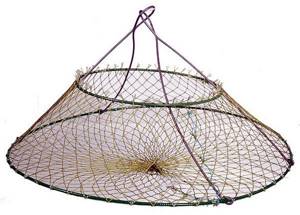
Improved plate
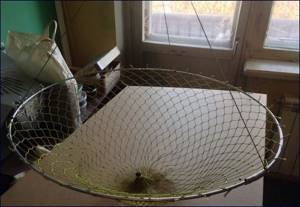
Plate
Structurally supplemented crayfish-grips are also classified as open crayfish traps.
Improved crayfish-plates consist of a large and small hoop. Accordingly, they are attached parallel to one another, but the small circle is located slightly higher than the large one and is not covered by the mesh.
Another improved clamshell is the inkwell. Structurally, it already has three hoops, the smallest is fixed in the middle of the second upper circle. The result is actually an isolated subspace.
Closed
Such devices are cylindrical structures 2-15 m long made of hoops. This is in the case of a lying structure. Although they often use smaller ranches. Their shape can be round or rectangular.
So, the simplest design of this type will be assembled from two hoops connected by a spring. Holes for crayfish entry are located at the ends. They are made from small hoops connected to large mesh and placed inside.
As an option, the rachevnya can be woven from aluminum wire in the shape of a large egg (up to 60 cm long), the blunt end of which bends inward and becomes a cylinder-collar. The hole at the collar is made 3-4 times smaller than the diameter of the blunt end of the egg. A solid disc-lid is made at the blunt end slightly larger than the diameter of the hole, in the middle of which a rope is tied and passed through the entire crayfish trap.

Rectangular
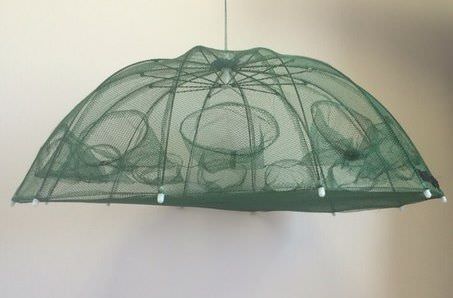
Umbrella
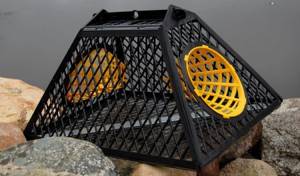
Plastic
The other end of the rope is brought out through the second hole of the rope opposite the sharp end of the same diameter as the blunt one. This shell is placed horizontally so that the bottom cover does not cover the hole. Raising the rack of this design does not require skill; just pull the rope and stand vertically at the rack and close the bottom with a lid. The version of the fishing tackle just described is an average in design between the crayfish catcher itself and another type of gear, namely a mesh.
Variations of closed ones include compact umbrella shells with several entrances. Their superiority is their small size and ease of removing the mesh from the base of the frame.
When fishing over a large area of a reservoir, long fishing lines with many entrances . They are prepared on the shore and then thrown to the bottom.
When catching crayfish , folding crayfish traps are used. Their design is designed to fit into a cut hole and is fully opened under the ice. When they are lifted to the surface, they are folded again, thereby making them compact.
Operating principle
- The bait is attached to the bottom of the crayfish trap. One of the methods described below.
- They lower her into the water.
- They wait for the crayfish to climb onto its surface or inside. Approximately no less than half an hour. More time may pass. Trivial advice: large specimens of crayfish sneak up on the bait later, driving away the young ones. So it’s worth trying to leave the crust on the bottom longer.
- Raise the crayfish trap sharply and carefully to the surface so that the crawling crayfish do not run away.
Types of crayfish
A fish catcher is a special device that significantly speeds up and simplifies the fishing process. Using this design, you don’t have to comb the bottom of the reservoir or wander along the shore with a flashlight: the crayfish themselves will swim to the fishing spot and fall into the trap (Figure 1).
It is not at all necessary to buy a ready-made clamshell: you can easily make such a design with your own hands, even without special skills.
All ranches are divided into two groups, each with its own advantages and disadvantages:
- Closed-type shells:
as a rule, they have a folding design. Such devices are very easy to make with your own hands, and the finished design is extremely easy to use and brings a good catch. In addition, such ranches are very easy to transport, which is especially important if the body of water is located far away. The structure is simply installed in the water column and checked every 5-7 hours. - Open structures: larger, so transporting them is much more difficult. In addition, they need to be checked every 30-50 minutes. Since the structure is open, crayfish can easily get out.
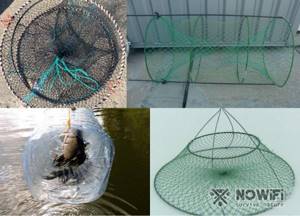
There is also another classification, according to which crayfish are divided into plastic, devices such as screen, inkwell, top and umbrella.
Methods for attaching bait in a crayfish trap
Let's look at all the ways to attach bait to a crayfish trap. The choice of attachment method depends on the type of bait. If the bait is combined, then to secure it to the bottom of the crayfish trap, appropriate methods for this bait are used. Only in this case, the main thing is that the various baits do not cover one another.
And another piece of advice - don’t pile up a lot of bait in the camp.
Tie with an elastic band
The most successful options for attaching bait with a rubber band are the following:
- A rubber band is used, which is wrapped around the bait several times.
- In the center of the shell, a rubber band is pulled like a string several times. The bait is placed under the rubber band and placed in the next one.
Put on a pin
Small bait (such as grasshoppers, worms and mole crickets) can be attached to a pin, which is threaded through the holes of the mesh.
Another option is to attach a piece of bait to a regular connecting small carabiner. Having previously made a hole in a piece of meat with a slate nail. The carabiner itself is attached directly to the mesh of the rachevny.
Place in a mesh bag
Bulk bait is placed in mesh bags. If it is not possible to use a mesh to sew the bag, then use gauze or old nylon stockings. In this case, additional holes are made. By the way, you can also use old fine mesh stockings.
Tie with wire
You can also tie the bait with wire or pierce pieces of meat, fish or other large and insoluble bait.
As an option, the intestines and large earthworms are put on a wire with a stocking. In this case, it is easier to attach them to a crayfish trap and combine them with additional bait.
Use a special hook to secure
It is convenient to place soft and medium bait, as well as rotten meat or, for example, a dead frog on a special hook, which can be found on sale.
As a replacement for a special hook, you can use fishing single hooks No. 14-16 or smaller tees. When using fishing hooks, take 5-8 of them per rack. Secure the hooks with fishing line to a wire wound to the bottom of the trap.
Distribution of bait by fishing period
At different times of the year, crayfish react differently to the type of bait:
- Bait for crayfish in spring. Small fish and fish fillets are good bait at this time of year. And you don’t have to catch it yourself; you can buy it in a store. To make crayfish smell the fish faster, the carcasses can be cut before starting fishing.
- Lure for crayfish in summer. In the summer, when there is enough food in reservoirs, animal meat or offal will be a good bait. You can buy them in advance at any store or market.
- Bait for crayfish in autumn and winter. Their catch during this period of time will be good, since the volume of food in reservoirs decreases and bread with garlic can be bait. To prevent the bread from turning sour quickly while fishing, it is recommended to wrap it with garlic in cheesecloth or weave it. It is better not to peel the garlic, but to stuff it into bread with the peel. During this period, many fishermen advise using non-fresh meat and fish.
Tactics and techniques for catching crayfish
Choose a bottom that is more or less flat, rocky, and rich in a variety of shelters. There may be a flooded snag nearby, steep clay banks, and thickets of water lilies are excellent landmarks.
The waiting time depends on the population of crayfish in the reservoir.
On average, the shells are raised after half an hour. When using open cone crayfish traps, they are left on the bottom a little longer.
There is no need to inspect inkwells often. The round crayfish trap is installed vertically and checked 2-3 times a day.
Tips and tricks
- When using an open crayfish, you need to wait for the crayfish to crawl onto the bait. After which they take it out sharply but carefully, trying not to knock it over.
- You can also leave a closed type clamshell overnight, for a day or several days. This depends on the size of the crayfish trap; the larger it is, the less frequently it is checked.
- The shape of the crayfish depends on the number of crayfish you want to catch. A round shell with a diameter of about 40 cm can catch 10 crustaceans at a time.
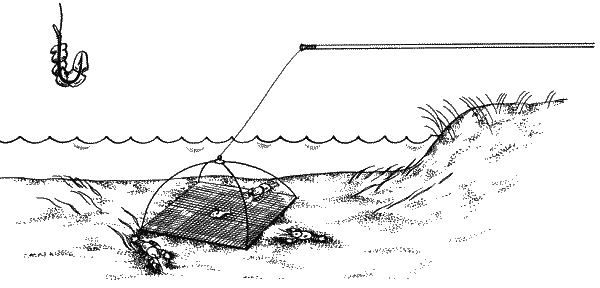
Option for installing an open shell.
Closed shells are installed from a boat or with a long pole from the shore. A float (plastic bottle or piece of foam) is attached to the top. You can also stretch a rope, thanks to which the crayfish trap will be fixed on the shore.- Another option for installing gear is to fix the rope from it to the stick. Even a child can master this fishing option. Because he won’t lose his tackle.
- Install each subsequent crayfish trap at a distance of 10 m from the previous one and at different depths. It is enough to use from 3 to 10 crayfish traps per person.
- If you plan to catch adult crayfish, use crayfish nets made of polyethylene fishing line. In the case of catching young crustaceans that still have a soft shell. It is better to use a crayfish catcher with nylon or cord threads. Such a net will not damage the shell of the young.
- You can use spoiled cabbage, banana peels and fruits as bait. Crayfish especially like overripe pears and melons.
- You can add a little blood to sunflower meal and pea porridge to attract crayfish.
